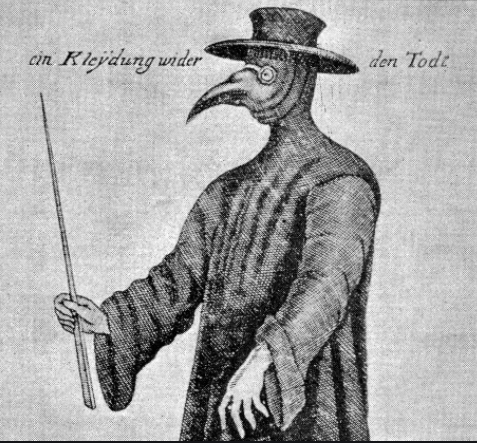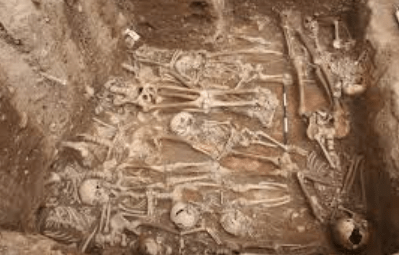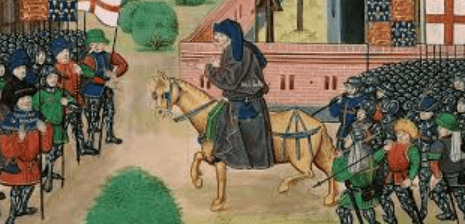By Cain O’Mahony
Feudal England should have been a very stable society. The key architect of the transition from slave-based society to feudalism was Fulk the Black, the Count of Anjou, in France. The mass armies of Roman times, capable of subjugating whole continents, had passed. Mass slavery, looted treasures and subject colonies could no longer provide the means of production.
In the new, static society, wealth transferred to ownership of the land around you, which was what now provided all sustenance for society. But with no continual source of slaves, who would provide the labour to farm it?
Fulk’s solution was to hand pick the toughest local thugs and train them in armoured warfare, to become his personal band of loricati or ‘cnights’ as the English called them. They would then pick the highest spot in the area, and build a small castella or castle on top of it. This was designed to intimidate, not protect. It was just large enough to provide shelter for his garrison, and not for the local populace when under threat, as the old walled cities had done.
Peasants herded together like human sheep
Fulk then declared all the land around him was his, and that the local peasants would now serve him, or answer to his ‘cnights’. Historian Tom Holland describes the fate of the peasantry:
“Rather than being left to live as they had done since Roman times, on scattered farms, or clustered around villas, or migrating year by year from hut to hut and field to field, peasants increasingly found themselves being herded together into what was in effect a human sheep pen: a ‘village’… They were all unfree now: living trophies, the spoils of violence and crime.” (Millennium).
Localised version of slavery
The art of the Castellan rapidly spread as other, mainly self-appointed, counts and routiers (robber barons) followed Fulk’s lead. It was a localised version of slavery, with the peasants forced to become servus or serfs, tied to the local lord and forced to work on his land.

This was underpinned by a universal theology enforced by the one church that your position in life was ‘God’s will’ and therefore to challenge the new established order was blasphemy. Society was administered by the church, a ‘civil service’ for the feudal state machine, keeping rigid control of the only communications network – the pulpit. It was ‘God’s will’ that that the Bible could only be produced in Latin, which in turn could only be understood by a select few of the priesthood, who would ‘interpret’ the Bible for the masses.
Thus, a strict pyramidic structure developed, with monarchy at the top, power enforced by a second layer of barony and lords, and a powerless mass of unarmed serfs, there only to do the bidding of God’s great and good.
Killing a third of the population
But then came the great equalizer. In August 1348 the Black Death ravaged the British Isles, killing a third of the population, whether the lord in his castle or the poor man at his gate.
Its aftermath produced a massive labour shortage for the following year’s harvest. The serfs realised they had the upper hand. They formed ‘brotherhoods’, combining together and using collective bargaining to force their lords to up the rates of pay, for both skilled and unskilled labour. Thatchers, who had been paid a penny a day, now demanded two and a half pence. The cost of bringing in extra labour to bring in the harvest for a typical village had been £3. Now it was £13.
Brotherhoods were banned
This infuriated the lords, and the king, Edward III, summoned a parliament to introduce a new Statute of Labourers. This made it illegal to demand pre-Black Death levels of pay. It became a crime to refuse to work for these levels of pay, and the brotherhoods were banned. This law would be enforced by a new agency called the Justices of the Peace (JPs).
It had little effect. There were too few JPs to enforce the ruling, and many lords, faced with either losing their harvest while they waited weeks for a JP to arrive, or negotiating a settlement with the local Brotherhood, chose the latter.
Even where the Statute of Labourers could be enforced, it only soured ‘industrial relations’ – as the churchman Henry Knighton complained: “From that time forth they served their masters worse from day to day than they had done previously” (Chronicon Henrici Knighton). The ‘go-slow’ had arrived.
John Wycliffe, the Marx of his day
But how could the serfs justify such blasphemy against God’s will? The Black Death had not just created a labour-shortage; it had driven a coach and horses through the concept of ‘divine rule’. It had killed lord and the commons alike. If man was equal in death, then why not in life?

The first to formulate this revolutionary concept was the Karl Marx of his day, John Wycliffe. This priest and master of Balliol College in Oxford had already put the case for ‘anti-sacerdotalism’, that is, it was the Bible that mediated between God and man, and not the priesthood. However, it was his 1374 work called De Civili Domini (‘civil lordship’) that argued that man only sinned because the things he needed for everyday life were in the ownership of a privileged elite, namely the monarch, the lords and the church. He wrote: “Firstly, that all good things of God ought to be in common. Every man ought to be in a state of grace… This will not happen until they hold all things in common; therefore, all things ought to be in common.”
Fighting the Poll Tax in 1380
This sent shockwaves through society, in particular amongst a new breed of radical priest, the most well-known being John Ball. As the peasant masses prepared to fight the Poll Tax on its introduction in 1380, Ball was imprisoned after preaching that “…the matters goeth not well to pass in England, nor shall do till everything be common, and that there be no villeins nor gentlemen, but that we may be all united together, and the lords be no greater masters than we be.”
The Black Death pandemic sowed the ground for the first mass revolt, the Peasants Revolt of 1381. To pay for the wars in France, the child king, Richard II – heavily influenced by his Royal Council led by John of Gaunt – had declared a Poll Tax, where every subject over the age of 14 would have to pay one groat, whether lord or serf.
The subsequent mass uprising was clearly well organised, a remarkable achievement given that communication was based on one horsepower; the revolt must have been pre-planned, with an organisation to ensure it was executed.
Peasants’ Revolt of 1381
The first revolt took place in Brentwood on 30 May. The next day, thousands were under arms in Essex and Kent. On 6 June, Rochester castle was captured. On 7 June, Maidstone was captured, the main aim being to free John Ball, who was imprisoned there. By 12 June, the 100,000 strong peasant army had captured London. In the mechanised 20th century, it took the Bolsheviks 10 days to shake the world. For 14th century serfs to take London in just 13 days is remarkable.

Sadly, the Peasants Revolt was crushed in the way that became a grim template for all future mass revolts, which appear to have taken place on a 40-year cycle: the Lollards movement of the early 1400s, the Kentish Rebellion of 1450, the Cornish Rebellion and Long March of 1497, and the ‘Pilgrimage of Grace’ rebellion in northern England of 1536.
As with the Peasants Revolt, each time the monarchy backed off and promised reform, and each time as soon as the peasants demobilised and separated, they were picked off and ruthlessly repressed, and all reforms reneged on. Too late, in 1381, John Ball realised that a more revolutionary policy was needed, arguing shortly before his death that: “…the Archbishop, the King’s counsellors, the lawyers and Justices were to be killed, as one weeds the ground before planting.”
During the last rebellion of the medieval period, the Kett Rebellion of 1549, the peasants were beginning to grasp the need for political revolution, forming peasants’ councils to discuss their tactics. Sadly, the rebellion suffered the same fate of its predecessors. But they did lay the foundation for future ideas and methods, that would influence the soldiers’ councils of the New Model Army a century later.
The Black Death was the spark for 300 years of revolt. And a warning for all future rulers – beware of pandemics, they are dangerous in more ways than one.



